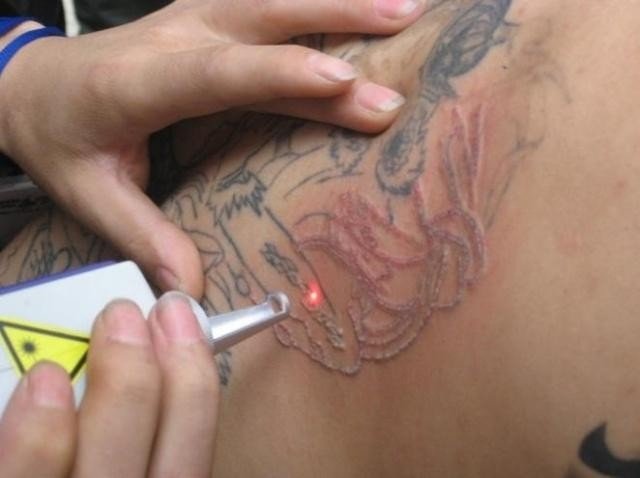Using Glass Slides To Reduce Pain During Tattoo Removal
Call Us Now
The tattoo removal business relies on experienced tattoo removal professionals to come up with innovative ideas. One such idea is the use of scientific glass slides in removing tattoos. The use of the glass slides is demonstrated to make the treatment more comfortable by reducing the pain experienced by the clients.
Mike Murphy, Chief Technology Officer at Medisico plc, devised this technique with a view to reducing the number of treatments required to remove a tattoo. Mike’s experience with tattoo removal and lasers is extensive having used ruby lasers since 1986 and Yags since 1990. Even with all that experience the outcome was not quiet what he was expecting; the number of treatments was not reduced by the use of this technique, but the clients experienced less pain during the treatment.
Initially Mike tested his theory, using a QSwitched Nd Yag laser on 133 patients. Unfortunately the study and subsequent report was rejected by the Laser Medical Science journal because a ‘side by side’ study was not undertaken. He then redid the study with a much smaller sample group of 31. All participants had Fitzpatrick skin types of 2-3 and 94% of the tattoos were professionally done.
Patients were asked to measure the pain of the treatment on a scale of 1-10; 1 being not painful and 10 being extremely painful. The measurement for pain averaged 6.97 without the glass slide and 3.84 with the slide. With a pain level of <4 then it is highly likely that you could eliminate numbing creams and ice packs, which could speed up the pre-treatment time.
As well as pain reduction when using these 1mm glass slides, there was the almost total elimination of pinpoint bleeding after the treatment. This has positive implications in treatment aftercare, significantly reducing the chance of infections. It can also reduce the costs treatments for the tattoo removal clinic… no more expensive dressings, bandages, swabs and antiseptic creams. It also reduces the chance of potential contamination of staff from infected blood exposure. Another pleasing outcome was that >93.5% of clients also reported less epidermal damage and oedema in the following weeks, so in theory you could do the treatments a closer intervals.
Mike explained his original plan, “I have been using this technique for nearly two years. My original idea was to find a way to accelerate the whole process resulting in fewer repeat sessions. I didn’t observe that but my patients immediately commented on the reduced pain levels!”
The fear of pain is often a reason why people don’t end up removing their unwanted tattoos so anything that can reduce pain levels, and in particular, cheaply and without contra-indications. The time it takes to remove a tattoo is also something that puts some potential clients off, so Mike also investigated using this technique using the R20 method.
“I have also combined the glass slide technique with the R20 approach. In one case nearly 95% of the ink was removed when the patient pulled his blister off, two weeks after the treatment. However, he was left with an open wound which took over three months to heal (all of his epidermis and a large chunk of his dermis were removed). While he eventually had an excellent result I would not recommend this technique for use with the general public. They just cannot be trusted to look after their skin properly post-treatment. The risk of infection is too high.”
Mike explains the details of the technique that he uses, “There are two issues to be aware of – first, the glass slide must be clean to prevent infection (of course!) Secondly, the 1mm thick slides can break if too much pressure is applied. I have done this a few times. While it is irritating it doesn’t break the skin (because of the direction of the break). I have recently been working with a 2mm thick slide. This is much better as there is no real risk of snapping it. However, it is not a standard microscope slide – I had to have them made up especially for me.”
“If you apply a thin layer of water-gel onto the skin surface before applying the slide then there is no significant loss in treatment fluidity. It takes a little practice but the technique is easy to apply. Reflections from the glass is important. Fresnel reflections can reflect around 4% of the incident energy, at each surface. Hence the slide can reflect up to around 8% of the incident fluence. You must always be wearing the correct safety glasses, minimum OD of 7 for these power densities. When you consider that an Nd:YAG can output hundreds of megawatts per sq cm, then even an 8% reflection will results in many megawatts per sq cm!!
The energy attenuation through such thin glass is negligible. Most of the losses are due to Fresnel reflections at each surface. I measured this with an Ophir meter and found a total loss of 7.8% +/- 0.3%, which agrees with the standard 4% per surface Fresnel loss. However, an 8% loss of incident energy will not make much of a difference to most treatments.”
We would love to hear from you if you decide to use this really interesting approach in your tattoo removal treatments. If you would like to share your outcomes then email helena@tattooremovalauckland.com
Further information regarding Mikes paper http://www.ncbi.nlm.nih.gov/pubmed/24584904
Mike Murphy, Chief Technology Officer at Medisico plc, 145-157 St John Street, London, EC1V 4PW, UK
helena@tattooremovalauckland.com
Home
Introducing Deink
Blog
Testimonials
Privacy Policy
Contact
